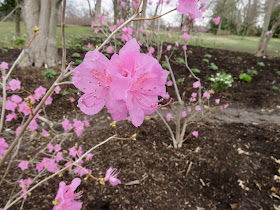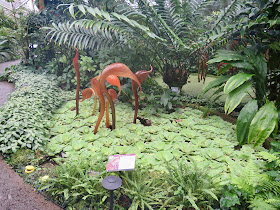For a long time, I’ve been interested in how we communicate with plants and how they talk to each other. Today we took our Triumph Tiger motorcycle to MotoEuropa in St. Louis for service, so it seemed the perfect opportunity to visit the Botanical Resonance: Plants and Sounds in the Garden exhibition at the Stephen and Peter Sachs Museum in the Missouri Botanical Garden. The museum gave us a glimpse into plant communication, but our overall garden experience on this cold, rainy day took that even further.
 |
| Daffodils under bald cypress. |
We started in the Linnaen house, walking among the containers of rare and different tropical plants. Upon entering the house, we immediately smelled the sweet and floral citrus flowers. We saw edible tea camelias, kumquat and fig, eerie buddha’s hand fruit, and rare plants that grow thousands of years old with only two leaves. Light pink Kangaroo paw flowers were fuzzy, and the light blue Echiums flowers exploded with fiberoptic stamens.
 |
| Linnaen House |
 |
| Two types of Echium. |
 |
| Kangaroo Paw |
 |
| Fragrant citrus blossoms |
Outside the house it started to sleet. The sound of sleet hitting the plants and ground and pavement was subtle and gentle. We passed a bell chimes sculpture and stopped to gently sway a couple of the musical chimes. The sounds of the garden moved us towards our destination. Along the way, patches of spring color emerged and drew us in. Magnolia, daffodil, snowdrops, glory-of-the-snow, and witch hazels exploded in shades of white, yellow, pink, and blue. Trees stood tall and proud on this winter day, showing off their stately structure as they reached towards the cloudy, gray skies. We walked through the mausoleum where hellebore bloomed among the groundcovers. A bright pink rhododendron moved and bopped up and down from the slight breeze and rain drops. All along the sound of the soft rain and sleet tinkled foliage and stems.
 |
| Hellebore |
 |
| Gory of the Snow |
 |
| Korean rhododendron (R. mucronulatum) |
Inside the steamy, warm climatron, the tropical plants lured us into their lush bounty. High above were palms and bananas and other trees. Below the luxurious foliage, vines, and flowers created harmony throughout. The sound of water dripping from the roof and irrigation and flowing in waterfalls and streams soothed us as we walked slowly along the curving pathway. Chihuly glass in blue and white hung from the climatron’s ceiling center – sparkling in the humid warmth in contrast to the gloomy skies beyond. Tall Chihuly orange “cattails” popped out of marshy pools of water lettuce and duckweed. Above them, a dead tree came alive covered in orchids, ferns, vines, and baskets of pitcher plants. One corner had all tropical edible plants like jackfruit, allspice, and cacao. We saw mangroves and banyan to remind us of our recent Florida trip. And, throughout the space, the sweet citrus blooms filled us with their floral scent.
 |
| Mark under waterfall in Climatron |
 |
| Chihuly glass in pool of water lettuce. |
 |
| Pitcher Plant |
 |
| Chihuly glass in Climatron |
 |
| Bridge in Climatron. |
At the end of the climatron was an activity center. One area highlighted sounds and plant communication. I pushed the various buttons with frequencies of humans, bats, dogs, cats, whales, and plants. Plants seemed to have no sound, yet they do communicate in various ways. Do grasses “scream” a grass smell warning when cut? Do trees talk via their underground wood wide web of fungi and plant interactions? I think they do.
The Sachs Museum exhibit took the idea of sound in the garden to new levels. According to their website, “The exhibition features different plants used to create musical instruments in cultures around the world, as well as how different plants make unique sounds throughout their lifecycles in nature and in the Garden. For the species used to make instruments, many often become jeopardized and threatened in their native environments due to the increasing production and demand for the desirable plant material. Botanical Resonance includes three contemporary artists who were commissioned to create artwork installations that interpret sound in several different ways: soundwalks by Annika Kappner, an immersive quilt installation by Brooke Erin Goldstein, and an immersive sound installation by St. Louis artist Kevin Harris.”
I had participated in a zoom call with the quilt exhibitor and wanted to see this it before the exhibition closes at the end of this month. The quilt room was impressive. An entire room was covered from ceiling to floor in quilts. The artist called it Reverberations, illustrating feelings and purpose behind the sounds of grasses above ground and tree roots below ground. The painted grasses on sheets and recycled fabrics “explored the screaming sound that grass makes when it is cut.” Underground she used transparent mesh fabric over quilt batting “to give a window into the symbiotic fungal system that make tree roots able to communicate, commonly known as the "wood wide web."
 |
| Reverberations - quilt covered wall - in Sachs Museum. |
Another area used glass showcases to feature instruments made from various wood types and plants. Rain sticks of bamboo, clarinet of boxwood, mahogany guitar necks, and different sized gourds on a xylophone were a few examples.
The bottom floor exhibit was an immersive listening experience using several speakers and wood blocks to feel the sound vibrations. Mark and I sat on the side on a bench and listened as the jungle and river sounds washed over and vibrated within us. Mark said it sounded eerie.
On our way out of the garden we stopped to admire the Merrill magnolia in full bloom. This hybrid magnolia (Magnolia kobus × M. stellata) is massive and quite impressive. It’s a solid mass of large white petals that reach all the way to the ground and back again to the sky.
 |
| Merrill Magnolia |
I am so glad that we didn’t let the weather keep us from experiencing the garden in a new and different way. The inclement weather only added to our communicating and learning experience with the plants. I go home with a new appreciation for how plants communicate. Maybe I’ll listen closer while mowing grass or hiking over tree roots.















No comments:
Post a Comment